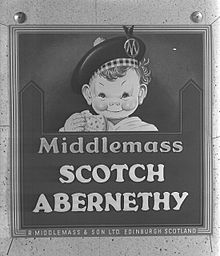Abernethy biscuit
L' Abernethy biscuit est un biscuit inventé par John Abernethy pour faciliter la digestion.


Historique modifier
Abernethy pensait que la plupart des maladies étaient dues à des troubles de la digestion. Le biscuit Abernethy est un type de biscuit digestif conçu à l'origine pour être consommé comme support à une bonne digestion[1]. En créant son biscuit, Abernethy suivait la tendance d'autres médecins praticiens comme William Oliver ou Sylvester Graham.
L'Abernethy biscuit connaît quelques occurrences historiques :
- William Gladstone l'utilise exclusivement pour son seul déjeuner[2].
- Dans le livret de l'opéra comique Princess Toto (en) de William S. Gilbert représenté pour la première fois le 24 juin 1876), le roi se déguise en biscuit d'Abernethy[3].
- Dans le premier roman de Charles Dickens, Les Papiers posthumes du Pickwick Club, le personnage de M. Solomon Pell est retrouvé, « à la cour, se régalant, [...], avec une collation froide d'un biscuit Abernethy et d'un saveloy (en) »[4].
Description modifier
Le biscuit Abernethy est une adaptation du biscuit de mer avec un ajout de sucre (pour l'énergie) et de graines de carvi réputées pour prévenir les flatulences[5]. Y est aussi ajouté du bicarbonate d'ammonium.
L'Abernethy biscuit est toujours populaire en Écosse. Il est fabriqué commercialement par Simmers (Édimbourg), Browns Bakery (Orcades), Walls Bakeries (Shetland) et Stag Bakeries (Île de Lewis)[6].
Notes et références modifier
- Abernethy Biscuits, in The Foods of England, 13 novembre 2014
- George William Erskine Russell, Seeing and Hearing, p. 169
- [PDF] W. S. Gilbert, Princess Toto – An entirely new and original English Comic Opera in Three Acts, The Gilbert and Sullivan Archive, p. 57.
- Charles Dickens, The Posthumous Papers of the Pickwick Club, 1836, p. 774
- Prosper Montagné, Larousse Gastronomique: The Encyclopedia of Food, Wine & Cookery, New York: Crown Publishers, Inc, 1961, p. 209–210
- Laura Halpin Rinsky, Glenn Rinsky, The Pastry Chef's Companion: A Comprehensive Resource Guide for the Baking and Pastry Professional, Chichester: John Wiley & Sons, 2009, p. 1
Bibliographie modifier
- Prosper Montagné, Larousse Gastronomique: The Encyclopedia of Food, Wine & Cookery, New York: Crown Publishers, Inc., 1961, p. 209–210
- Alan Davidson, The Oxford Companion to Food, Oxford: Oxford University Press, 2006, p. 78